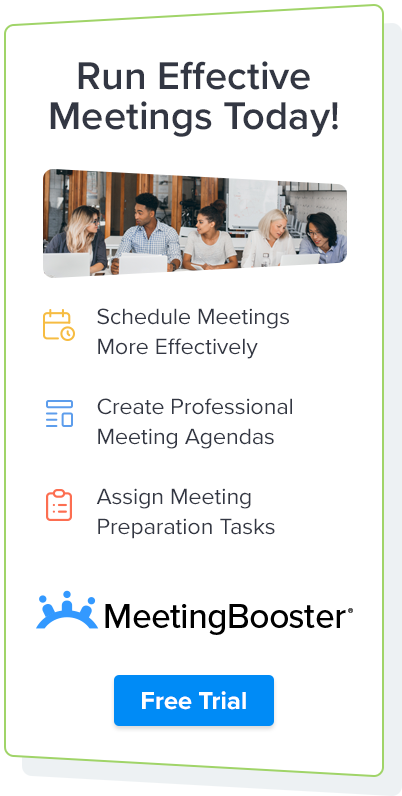This website uses cookies to improve user experience.
Why meeting rules are important
Meetings cannot be productive without rules. However, this doesn't mean that more rules necessarily equal greater productivity. You must instead find the right balance of rules according to your organization's meetings. In some cases, fewer rules help meetings run more smoothly. In others, more rules help maintain order.
Rules govern how frequently meetings take place, the procedure that meetings follow, and how attendees can participate in meetings. MeetingBooster meeting management software can help you to set rules and assist meeting attendees in following them. Read more about the three categories of meeting rules so you can decide how to create rules specific to your organization's needs and implement them through your software.
The three categories of meeting rules
1Rules for meeting frequency
The rules for how frequently an organization meets vary according to the organization's needs. All meetings, though, fall into one of two frequency categories: regular meetings and special meetings.
Regular meetings can take place once per quarter, month, or week, or however frequently your organization needs to convene to conduct important business. You know ahead of time when these meetings take place, so you can schedule them as far in advance as possible. With MeetingBooster, you can integrate the meetings into calendars like Microsoft Outlook and Google Calendar. Attendees also know well ahead of time when these meetings will take place, so there should be no scheduling conflicts.
Special meetings take place on an ad hoc basis, basically to discuss an important issue when it crops up. Scheduling these types of meetings to maximize attendance can present a challenge because some invitees might have a conflict with the date and time you select. MeetingBooster has a conflict resolver, which can review invitees' calendars and determine which time slot will maximize attendance.
See how MeetingBooster helps can help you set rules for meeting frequency!
2Rules for meeting procedure
Having rules of procedure helps meetings run efficiently. And the first and most basic rule for meeting procedure is: follow your meeting agenda. When you create a meeting agenda, recording attendance and accepting meeting minutes from the previous meeting should be the first two orders of business. You can prepare and distribute your meeting agenda directly in MeetingBooster. The software also helps your secretary record and archive minutes during one meeting so that you can quickly pull them up for approval in the next meeting.
Once the attendees have approved the minutes from the previous meeting, it's time to discuss new business. Most organizations use Robert's Rules to encourage greater participation by attendees.
Robert's Rules apply to both larger and smaller meetings, with more rules in place for the former. In larger meetings, an attendee makes a "motion" to introduce a new piece of business. Another attendee can propose to "postpone indefinitely" the motion in order to kill it or "amend" to change it. Other attendees must second the motion, postpone it indefinitely, or amend it before a majority vote takes place on how to proceed. To assign a motion to a committee outside the meeting, attendees "commit" it. They call it to "question" to vote on the motion and "table" it to delay the vote until later in the meeting or a future meeting. The meeting is adjourned by a separate motion.
A condensed version of Robert's Rules applies to smaller meetings, such as committee meetings and board meetings. In these, attendees introduce, change, and adopt motions and adjourn the meeting. If your meetings tend to be less participatory, attendees can simply follow the lead of the meeting chair.
Use MeetingBooster to create agendas that ensure meetings proceed according to your rules!
3Rules for meeting participation
Many organizations have rules for who participates in their meetings and how they participate. If your organization has committees, members of each one attend only their committee's meetings. You can also decide that only employees of a certain seniority level and above can attend specific meetings. You set the rules on who can participate, but these rules vary from organization to organization based on their needs.
Organizations also use a parliamentary procedure that describes what to say in order to do certain things, such as adjourn the meeting, end a discussion, and vote. This procedure also specifies when someone can and cannot interrupt the speaker, when a motion requires seconding, whether attendees can discuss the motion or not, and how many votes are necessary to pass a motion or whether the chair decides.
Parliamentary procedures can be complex, so use MeetingBooster to attach your procedure to the meeting agenda you distribute to attendees. This will help attendees remember the procedure to follow.
Learn how MeetingBooster makes it easy to distribute your meeting rules!
Tips for setting meeting rules
- Meetings with more attendee participation require more detailed rules, including a parliamentary procedure, to help maintain order
- Closely following the agenda helps meeting attendees also follow the rules; straying from the agenda can break down order
- You do not have to use Robert's Rules, but they offer a helpful template to follow if you are unsure of which rules to set for meeting procedure
Why use MeetingBooster to make meeting rules
- Type up the rules in the software and easily collaborate with others before finalizing the rules
- Distribute and archive the rules so that attendees can familiarize and refresh themselves on the rules before each meeting
- Use the software's calendar integration to schedule regular meetings well ahead of time and its conflict resolver to maximize attendance for special meetings
